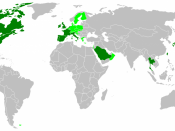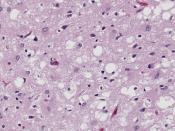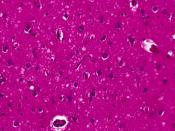Prion Disease: Cruetzfeldt-Jacob Disease
By: Amy Cummings
Microbiology 1913
Mrs. Anita Hampton
Georgia Perimeter College
Summer 2004
Prions are proteins that are found in the nerve cells of all mammals. Numerous prions are in each nerve cell, but no one knows for sure what the prion protein does. The brain of a human or animal infected with a prion "disease" has many abnormally-shaped prions. One hypothesis states that when a person or animal ingests an abnormally-shaped prion from contaminated food the abnormally-shaped prion gets absorbed into the bloodstream and crosses into the nervous system. The abnormal prion touches a normal prion and changes the normal prion's shape into an abnormal one, thereby destroying the normal prion's original function. Both abnormal prions then contact and change the shapes of other normal prions in the nerve cell. The nerve cell tries to get rid of the abnormal prions by clumping them together in small sacs that merge with its lysosome.
However, the nerve cells cannot digest the abnormal prions, and they accumulate in the lysosomes. The lysosomes grow and engorge the nerve cell, which eventually lysis. Next, the abnormal prions are released to infect other cells. Large, sponge-like holes are left where the cells lysed. Numerous nerve cell deaths lead to loss of brain function, and the person eventually dies. (howstuffworks.com/mad-cow-disease4.htm)
Prions first came to public attention in the mid 1980s in the form of the bovine spongiform encephalopathy (BSE, or "mad cow disease") epidemic in the United Kingdom. Mad cow disease is a prion disease in cattle. There is a theory that mad cow disease came from feed contaminated with scrapie, the long established sheep prion disease. In the 1980's, producers of cattle feed (which often included ground meat and bone meal byproducts from sheep) changed the way they processed feed.


